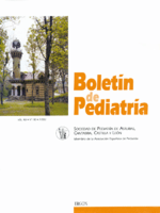Infecciones bacterianas con cultivos centrales positivos en niños de edad inferior a 1 año. Estudio epidemiológico evolutivo de 14 años
J. Rodríguez Calleja , M.I. Carrascal Arranz , C. Alcalde Martín , A. Peña Valenceja , A. Blanco del Val , S. Marín Urueña
Bol. Pediatr. 2002; 42 (180): 100 - 105
Objetivos: Analizar los cultivos centrales positivos en niños con infección en pacientes ingresados con edad inferior a 1 año. Pacientes y métodos: Los criterios de selección de los pacientes fueron edad inferior a 1 año, y cultivos centrales bacterianos positivos. El período de observación fue de 14 años. Se excluyeron los pacientes de la Unidad de Neonatología y niños de especialidades quirúrgicas que ingresaron en el Servicio. Resultados: De los 3.664 niños ingresados con edad inferior a 1 año, 455 (12,4%) tenían algún cultivo bacteriano central positivo. Por orden de frecuencia los cultivos centrales positivos fueron: urocultivos (207), coprocultivos (193), hemocultivos (30) y cultivos de LCR (25). Predominaron los gérmenes Gram (-): 96,1% en urocultivos, 100% en coprocultivos, 76,6% en hemocultivos y 88% en cultivos de LCR. Los gérmenes más frecuentes fueron: E. coli en urocultivos y hemocultivos, Salmonella en coprocultivos y Neiseria meningitidis en cultivos de LCR. Existió un descenso en los últimos años de cultivos para N. meningitidis y H. influenzae; también se observó descenso en los coprocultivos (R2 = 0,559, p < 0,05) relacionado con el descenso de Salmonella. La edad media de los pacientes con hemocultivos positivos (3,26 +/- 3,1 meses) fue estadísticamente inferior al comparar con otros grupos (p < 0,0001). El tratamiento inicial, previo al antibiograma, fue: cefalosporina de 3ª generación o tobramicina y ampicilina. Fallecieron 3 pacientes que representan el 0,65%, en los últimos 10 años del estudio no se observó ningún fallecimiento. Conclusión: Los niños con edad inferior a 1 año con cultivos centrales positivos superaron el 10% de los niños ingresados de esa misma edad. Esta cifra y la posible gravedad de las infecciones justifican una encuesta bacteriológica amplia y un diagnostico precoz para lograr una morbi-mortalidad baja. Abstract Objective: Analyze the positive central cultures in children with infection in hospitalized patients under 1 year of age. Patients and methods: The selection criteria of the patients were age under 1 year and positive central bacterial cultures. The observation period was 14 years. Patients from the Neonatology Unit and child from surgical specialties who were admitted to the Service were excluded. Results: A total of 455 (12.4%) of the 3,664 children admitted under 1 year of age had some positive central bacterial culture. By order of frequency, the positive central cultu-res were: urine culture (207), stool cultures (193), blood cultures (30) and CSF cultures (25). Gram (-) germs predominated: 96.1% in urine cultures, 100% in stool cultures, 76.6% in blood cultures and 88% in CSF cultures. The most frequent germs were: E. coli in urine and blood cultures, Salmonella in stool cultures and Neiseria meningitidis in CSF cultures. In recent years, there has been a decrease in the cultures for N. meningitidis and H. influenzae; A decrease was also observed in the stool cultures (R2 = 0.559, p < 0.05) related with the decrease in Salmonella. The mean age of the patients with positive blood culture (3.26 +/- 3.1 months) was statistically lower when compared with other groups (p < 0.0001). The initial treatment, prior to the antibiogram was: 3rd generation cephalosporin or tobramycin and ampicillin. Three patients died, representing 0.65%, and no death was observed in the last 10 years of the study. Conclusion: The children whose age was inferior to 1 year with positive central cultures exceeded 10% of the children of this same age hospitalized. This value and the possible seriousness of the infections justify an extensive bacteriological survey and an early diagnosis to achieve a low morbidity-mortality.
\N
\N
Artículo completo (PDF) (38 kb.)
- Infectología
